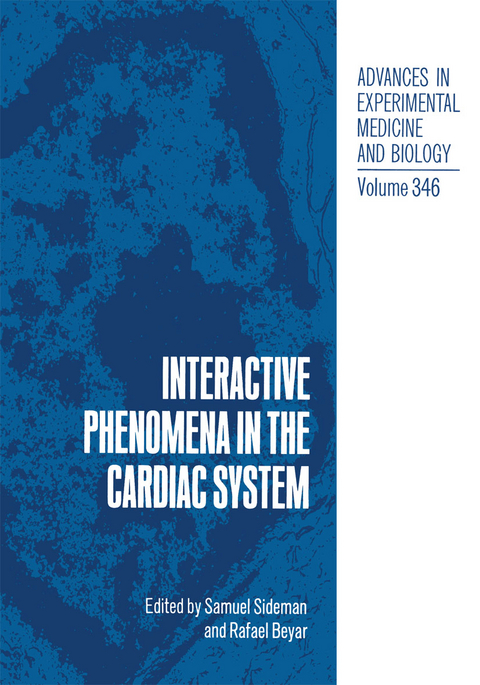
Interactive Phenomena in the Cardiac System
Springer-Verlag New York Inc.
978-1-4613-6280-7 (ISBN)
Cell to Organ: Electromechanical Activation.- 1 Regulation of Intracellular Calcium in Cardiac Muscle.- 2 Neuromodulation of Calcium Current by Extracellular ATP in Isolated Ventricular Myocytes.- 3 Intracellular Calcium and Myocardial Function during Ischemia.- 4 Intracellular Signaling in Vascular Smooth Muscle.- 5 Myocardial Energetics.- 6 Mechanisms of Endocardial Endothelium Modulation of Myocardial Performance.- 7 Calcium Kinetic and Mechanical Regulation of the Cardiac Muscle.- 8 Cellular Responses to Electrical Stimulation: A Study Using a Model of the Ventricular Cardiac Action Potential.- 9 Excitation-Contraction Coupling and Contractile Protein Function in Failing and Nonfailing Human Myocardium.- Mechanics and Microcirculation.- 10 Estimation of Myocardial Mechanical Properties with Dynamic Transverse Stiffness.- 11 Intramyocardial Mechanical States: Vessel-Interstitium-Muscle Interface.- 12 Myocardial Mechanics and Coronary Flow Dynamics.- 13 Modeling of Coronary Capillary Flow.- Microstructure: Mechanics and Microcirculation.- 14 Models for Coronary Pressure-Flow Relationships.- 15In VivoMyocardial Microcirculation: Evaluation with a Whole-Body X-Ray CT Method.- 16 Endocardial Coronary Microcirculation of the Beating Heart.- 17 Distribution and Control of Coronary Microvascular Resistance.- 18 Theoretical Analysis of Coronary Blood Flow and Tissue Oxygen Pressure-Control.- Microcirculation and Metabolic Transport.- 19 Adenosine Coronary Vasodilation during Hypoxia Depends on Adrenergic Receptor Activation.- 20 Chaos in Cardiac Signals.- 21 Intramyocardial Fluid Transport Effects on Coronary Flow and Left Ventricular Mechanics.- 22 Metabolic Protection of Post-Ischemic Phosphorylation Potential and Ventricular Performance.- 23 Metabolic and Mechanical Control of the Microcirculation.- Remodeling of Muscle and Vessels.- 24 Asymmetrical Changes in Ventricular Wall Mass by Asynchronous Electrical Activation of the Heart.- 25 Ventricular Remodeling after Myocardial Infarction.- 26 Arterial Remodelling after Percutaneous Transluminal Balloon Angioplasty.- 27 Structural and Functional Remodeling of Poststenotic Arteries in the Rat.- 28 Myocardial Collagen and Its Functional Role.- Cardiac Function and Circulation.- 29 Ventricular-Arterial Interaction: Cardiac Effects of Mean versus Pulsatile Arterial Load.- 30 The Veins and Ventricular Preload.- 31 Why Smaller Animals Have Higher Heart Rates.- 32 Feedback Effects in Heart-Arterial System Interaction.- Integrated Analysis.- 33 The Relationship between Altered Load and Impaired Diastolic Function in Conscious Dogs with Pacing Induced Heart Failure.- 34 Interactions: The Integrated Functioning of Heart and Lungs.- 35 Carotid-Cardiac Interaction: Heart Rate Variability during the Unblocking of the Carotid Artery.- 36 Right and Left Ventricle Interaction and Remodeling in Congenital Heart Disease.- 37 Macroscopic Three-Dimensional Motion Patterns of the Left Ventricle.- 38 Cardiovascular Flow Velocity Measurements by 2D Doppler Imaging for Assessment of Vascular Function.- The Editors.- Contributors.
| Reihe/Serie | Advances in Experimental Medicine and Biology ; 346 |
|---|---|
| Zusatzinfo | XVI, 428 p. |
| Verlagsort | New York, NY |
| Sprache | englisch |
| Maße | 178 x 254 mm |
| Themenwelt | Naturwissenschaften ► Biologie ► Botanik |
| Naturwissenschaften ► Biologie ► Zoologie | |
| Naturwissenschaften ► Physik / Astronomie ► Angewandte Physik | |
| ISBN-10 | 1-4613-6280-6 / 1461362806 |
| ISBN-13 | 978-1-4613-6280-7 / 9781461362807 |
| Zustand | Neuware |
| Haben Sie eine Frage zum Produkt? |
aus dem Bereich


